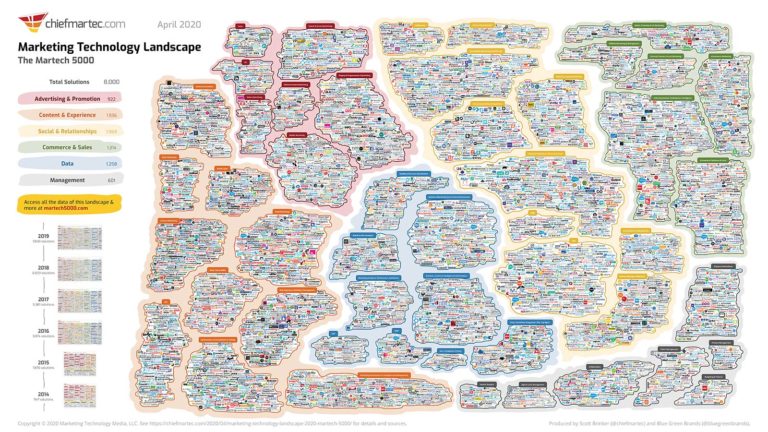Enterprise content marketing teams would quickly become siloed and overwhelmed without the help of technology. Can you imagine the struggle without tech? Workflows and organization would be in chaos. But finding the right martech (marketing technology) for content marketing requires an understanding of what your needs are and how technology can address them.
If your team is revisiting its martech stack, you’ll want to make sure the stack enables and empowers your content marketers to deliver consistent, relevant content on time and in the right channels.
Let’s look at what you should expect out of a content marketing martech stack.
A Strategic Approach to Martech

Image Source: ChiefMartech.com
The world of martech is massive and changing every day. New tools appear regularly because the barrier to entry is low. But don’t get distracted by “new.” If you keep adding new tech, your stack may end up like a Jenga puzzle. Instead, be strategic about how you create your stack, ensuring interoperability between systems. This is the path you want to take for having technology that truly supports your content creators every day.
What Do You Need in Your Martech Stack for Content Marketing?
To answer this question, start with your content strategy. It’s your content bible, so it will provide a lot of insight into what technology features you need. Your content strategy provides the outline of what you’ll create, how you’ll target audiences, what channels you’ll use, and metrics you want to track.
Your Content Plan Informs Your Martech Needs
You’ll develop the content plan from your strategy. The plan is the actionable steps for executing your strategy. In your content plan, you’ll likely outline six key elements:
- Documenting processes and workflows
- Creating content calendars
- Onboarding and training of new team members
- Promotion and distribution
- Transparency and communication guidelines to foster collaboration
- Measuring and optimizing content
Each of these pillars of your plan requires technology. Let’s look further at each and how you can use your martech stack to streamline everything.
Documenting Processes and Workflows
Enterprise content teams comprise a unique blend of skillsets and team members. However, without documented processes and workflows, it’s easy to get derailed. Every piece of content requires a series of tasks to be completed. If you aren’t managing this with a content marketing platform, you risk not meeting your goals.
Additionally, without implementing processes and workflows, you could end up with duplicated work and an inability to ensure accountability. Things can get out of hand fast. And using spreadsheets doesn’t count as martech! While they may be sufficient for small teams, they further disjoint and silo large teams.
Content Calendar

Image: DivvyHQ Mobile Calendar
A content calendar is the central repository for your content marketing schedule. It provides accurate visibility into the status of projects and keeps your workflows moving. It’s one of the most vital aspects of a content marketing martech stack.
Your content calendar shouldn’t be a Google doc—that’s just a shareable Word document. It’s not dynamic. Instead, use an enterprise content calendar that’s constantly updated and easy to use. When looking at options, be sure you can:
- Organize groups by teams, regions, or lines of business.
- Manage by task, asset, or campaign.
- Filter by keywords, categories, and teams.
With a fluid, tech-powered content calendar, you’ll have a hub for all your efforts and can develop a repeatable process for every project.
Plus, a content calendar can be the end of status updates via meetings and emails. Everything’s in the calendar, so users can find those answers fast, instead of losing productivity to engage in emails or calls.
Onboarding and Training of New Team Members
Enterprise teams add new members regularly. How will you get them up to speed? By including a way to onboard them into your content plan. This process is easy when you have technology in place that defines workflows. New additions to the team can quickly get into the groove and begin contributing.
Promotion and Distribution
Promotion and distribution are core to content marketing. You’ll need to use numerous channels to get your content in front of the right audience. Technology can help. First, you’ll want to use a content automation tool that integrates with your website and social media profiles. There are many options but using a tool inside a content marketing platform is one of the most efficient.
If you use a separate social media tool, you’ll have to take extra steps to schedule your post. While this may only add minutes to your workflows daily, over time, these minutes can really add up. If you’re doing this in one hub, it streamlines the process, so those small tasks don’t become huge ones.
Another element of distribution and content automation is your email marketing tool. Email remains an excellent channel for engagement and nurturing. Being able to set up drip campaigns or autoresponders based on buyer behaviors is critical to getting the most out of email marketing and turning an interest, into a conversion.
Transparency and Communication
It’s time to break down those barriers that impede content collaboration. It takes a team to build world-class content, and that includes people outside your content creators. You likely want to involve subject matter experts (SMEs) like product managers, sales, and even legal and compliance, if you’re in a regulated industry.
You can improve content collaboration with technology. With your martech stack, look for a tool that enables sharing content calendars, project management tools, idea repositories, and real-time notifications. With this framework, all stakeholders can come together, ensuring you hit deadlines and deliver quality content.
Measuring and Optimizing Content
The final aspect of planning is content analytics. You have data streams coming from multiple sources regarding the performance of your content—social media sites, email, website metrics, and more. To simplify the collection and analysis, look to aggregate data on one platform. This saves you time and gives you a complete picture of performance. Use what you learn to improve and optimize going forward.
Is DivvyHQ the Right Addition to Your Martech Stack?
It’s hard to find one platform that does it all. DivvyHQ answers the need in every category. We built it for enterprise teams that are committed to content marketing as a growth strategy. Try it out for free today!